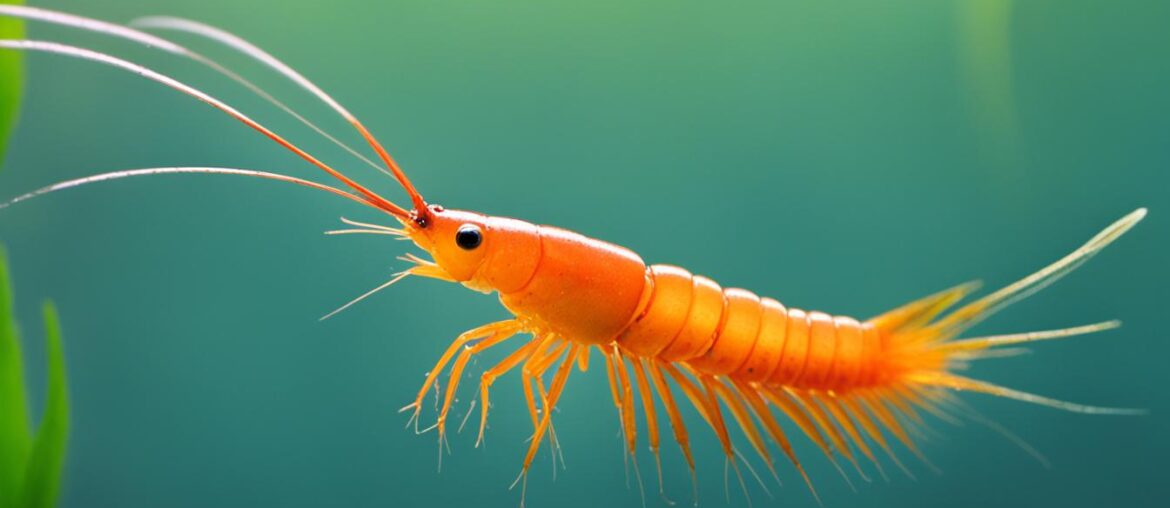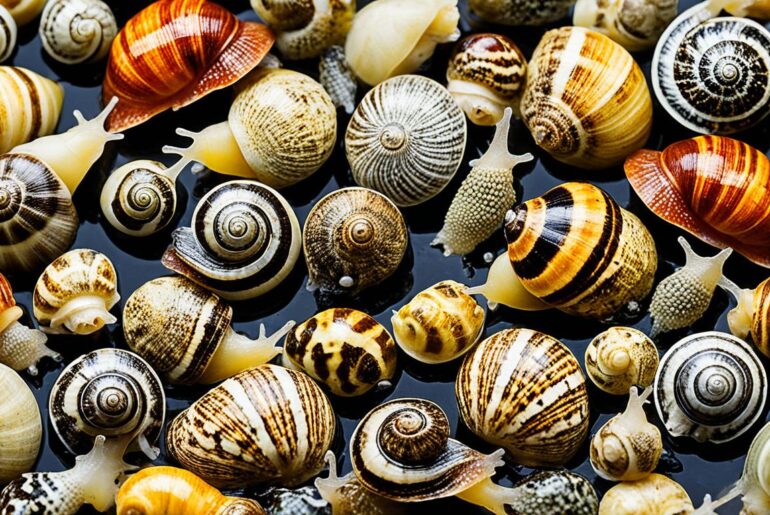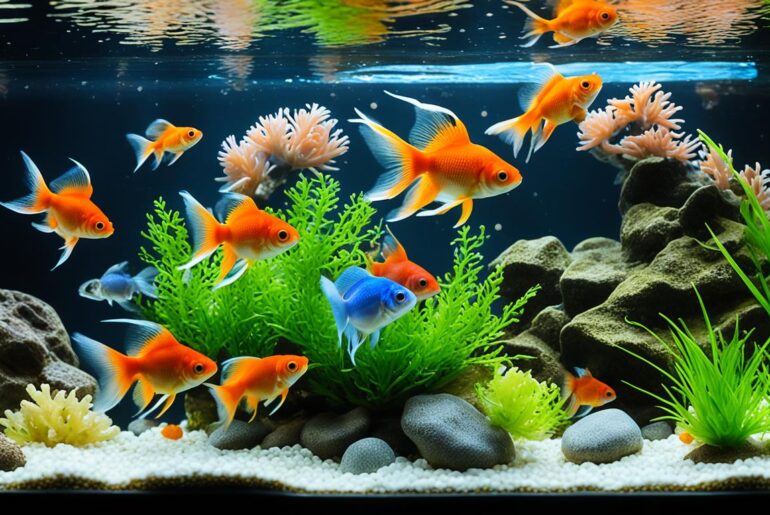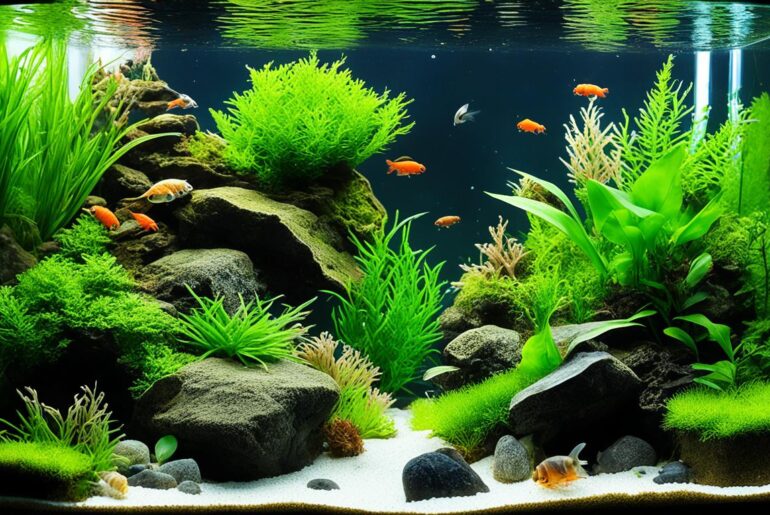Are you striving to provide the best care for your freshwater shrimp? One of the key factors for their thriving is setting up the ideal water parameters. But here’s the question: do you really know the optimal water conditions for your shrimp? Are you confident that you’re providing them with the perfect environment?
Today, I’m going to dive into the world of freshwater shrimp care and reveal the secrets to maintaining optimal water conditions in your shrimp tank. By understanding and implementing the right water parameters, you can ensure the health and well-being of your beloved aquatic companions.
Key Takeaways:
- Understanding the specific water requirements of your shrimp species is crucial for their well-being.
- Neocaridina and Caridina are the two main genuses of freshwater shrimp commonly kept in aquariums.
- Neocaridina shrimp tolerate a wider range of water parameters, while Caridina shrimp have more specific requirements.
- Setting up a suitable tank and providing appropriate tankmates are essential for the overall health of your shrimp.
- Maintaining consistent water quality and monitoring parameters is crucial for the long-term success of your shrimp tank.
Understanding the Different Genuses of Freshwater Shrimp
When it comes to keeping freshwater shrimp in aquariums, there are two main genuses that are commonly encountered: Neocaridina and Caridina. Understanding the differences between these genuses is essential for creating the ideal environment for your shrimp.
Neocaridina shrimp, which include popular species like the Red Cherry Shrimp, are known for their hardiness and adaptability. They are resilient creatures that can thrive in a variety of water conditions, making them an excellent choice for beginners. Neocaridina shrimp are often referred to as freshwater dwarf shrimp due to their smaller size compared to some Caridina species.
The Neocaridina Genus
“Neocaridina shrimp, such as the Red Cherry Shrimp, are hardy and adaptable, making them popular choices for beginners.”
On the other hand, Caridina shrimp require more precise care and specific water parameters. The Caridina genus encompasses a wide range of species, each with its own unique set of requirements. Caridina shrimp are known for their stunning colors and patterns, which can vary greatly between species. Taking the time to research and understand the specific needs of Caridina shrimp is crucial for their well-being.
The Caridina Genus
“Caridina shrimp, with their vibrant colors and patterns, require more precise care and specific water parameters.”
By understanding the differences between Neocaridina and Caridina shrimp, you can set up the ideal water parameters and provide the best care for your freshwater shrimp. Whether you choose the hardy adaptability of Neocaridina shrimp or the striking beauty of Caridina shrimp, creating a suitable environment will ensure the health and happiness of your aquatic companions.
Water Chemistry Details for Neocaridina Shrimp
Neocaridina shrimp, such as the popular Red Cherry Shrimp, are known for their tolerance to a wide range of water parameters. This makes them ideal for beginners and those looking for low-maintenance shrimp. Understanding the specific water conditions that Neocaridina shrimp thrive in is essential for their overall health and well-being.
Neocaridina Temperature
Neocaridina shrimp are comfortable in temperatures ranging from 65°F to 84°F (18°C to 29°C). This wide temperature range allows them to adapt well to various aquarium setups.
Neocaridina pH
The optimal pH level for Neocaridina shrimp falls between 6.5 and 8.0. Maintaining this pH range ensures that the shrimp’s biological processes function properly and minimizes stress.
Neocaridina GH and KH
When it comes to water hardness for Neocaridina shrimp, the general hardness (GH) should be within 4-8 dGH, while the carbonate hardness (KH) should be within 3-15 dKH. These ranges provide the necessary minerals and stability for the shrimp’s overall health and successful reproduction.
Let’s summarize the ideal water parameters for Neocaridina shrimp:
| Water Parameter | Ideal Range for Neocaridina Shrimp |
|---|---|
| Temperature | 65°F – 84°F (18°C – 29°C) |
| pH | 6.5 – 8.0 |
| General Hardness (GH) | 4-8 dGH |
| Carbonate Hardness (KH) | 3-15 dKH |
Providing an environment that meets these Neocaridina water parameters will ensure the shrimp’s well-being and promote their vibrant colors and active behavior.

Water Chemistry Details for Caridina Shrimp
When it comes to Caridina shrimp, such as Crystal Red Shrimp and Tangerine Tigers, maintaining precise water parameters is essential for their optimal health and coloration. These shrimp have more specific requirements compared to their Neocaridina counterparts.
Caridina Temperature
Caridina shrimp prefer cooler temperatures ranging from 64°F to 76°F (18°C to 24°C). This temperature range mimics their natural habitats, providing them with the ideal conditions for growth and reproduction.
Caridina pH
The pH level of the water should be maintained between 6.0 and 7.5 for Caridina shrimp. This slightly acidic to neutral pH promotes their overall well-being and enables them to exhibit their vibrant colors.
Caridina GH and KH
When it comes to general hardness (GH) and carbonate hardness (KH), Caridina shrimp have specific requirements. The GH should be within 4-6 dGH, while the KH should be within 0-2 dKH.
These parameters mimic the conditions of their native habitats and contribute to the shrimp’s health and ability to molt successfully. Maintaining the proper GH and KH levels ensures that Caridina shrimp can fully display their exquisite colors and patterns.
It’s crucial to monitor and adjust these water parameters regularly to provide an environment that promotes the well-being and longevity of Caridina shrimp.
| Water Parameters | Recommended Range |
|---|---|
| Temperature | 64°F – 76°F (18°C – 24°C) |
| pH | 6.0 – 7.5 |
| GH | 4-6 dGH |
| KH | 0-2 dKH |
Tank Setup for Freshwater Shrimp
Creating an optimal tank setup is essential for ensuring the well-being of your freshwater shrimp. By choosing the right tank size, filtration system, and substrate, you can provide a conducive environment for their growth and development.
Choosing the Right Tank Size
When it comes to tank size, it’s recommended to have a minimum of 5 gallons of water for keeping shrimp. This provides enough space for the shrimp to move around comfortably without feeling cramped. A larger tank volume also helps maintain stable water parameters.
Selecting the Ideal Filtration System
A reliable filtration system is crucial for maintaining the water quality in your shrimp tank. Sponge filters are often the preferred choice for shrimp tanks as they provide gentle water flow without risking harm to the delicate shrimp. The sponge media also serves as a natural habitat for beneficial bacteria, aiding in biological filtration.
Providing the Right Substrate
The substrate you choose should not only be visually appealing but also practical for the shrimp. Opt for a substrate that allows shrimp to grip and scavenge for food effectively. Fine-grained substrates like sand or smooth gravel are ideal choices that meet these requirements.
Adding Essential Equipment
There are a few additional equipment items that you should consider for your shrimp tank. These include:
- Heater: Shrimp thrive in temperatures within specific ranges, depending on the species. Installing a heater with a thermostat ensures that the water temperature remains stable.
- Hardscape Elements: Including driftwood and rocks in your tank provides hiding spots and surfaces for biofilm growth, which is perfect for the shrimp to graze on.
- Live Aquatic Plants: Adding live plants not only enhances the aesthetic appeal of the tank but also helps maintain water quality by absorbing excess nutrients and providing shade and shelter for the shrimp.
Aquascaping Inspiration
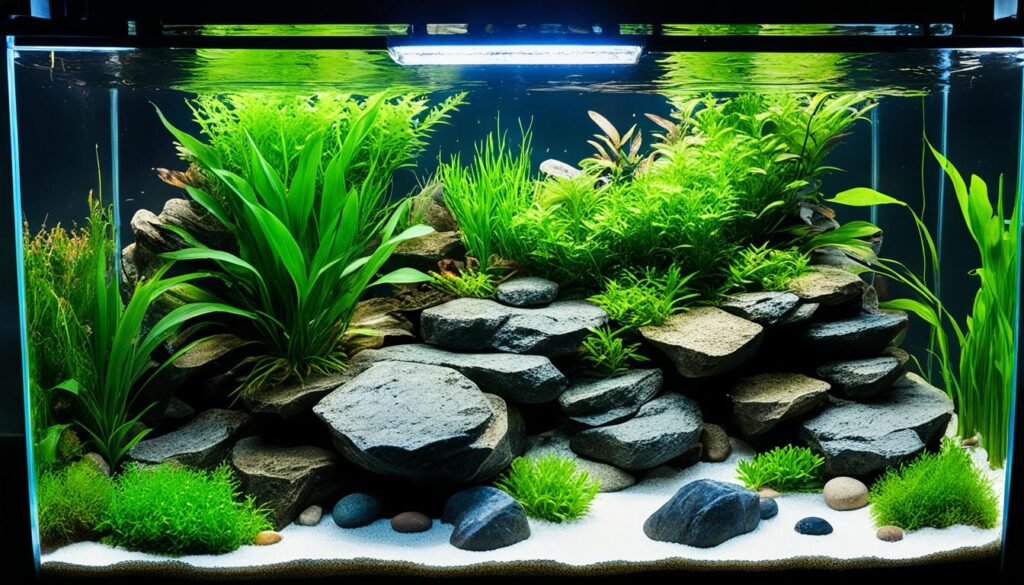
“A well-designed shrimp tank is not only visually captivating but also provides a thriving ecosystem for these fascinating creatures. By combining lush greenery, natural hardscape elements, and a carefully selected substrate, you can create a captivating underwater landscape that your shrimp will call home.”
Remember, providing a suitable tank setup is just the first step. Regular maintenance, monitoring water parameters, and addressing any issues promptly are also essential for the long-term health and happiness of your freshwater shrimp.
Tankmates for Freshwater Shrimp
When it comes to selecting tankmates for your freshwater shrimp, it’s essential to choose species that are compatible and won’t prey on the shrimp. By carefully considering the size and temperament of other tank inhabitants, you can create a harmonious community aquarium that promotes the well-being of your shrimp.
Small, Peaceful Fish:
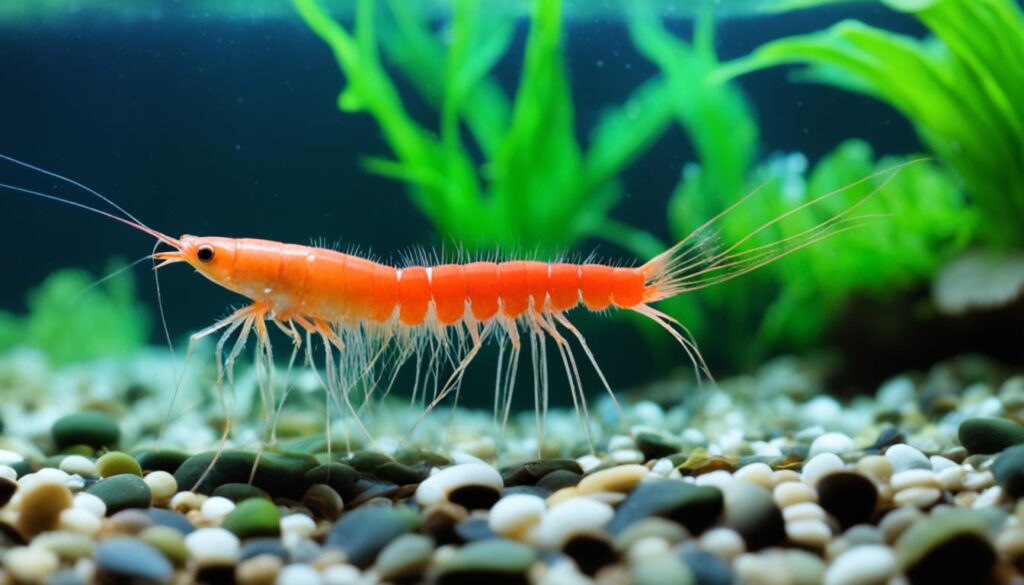
One option for tankmates is small, peaceful fish that won’t bother or harm the shrimp. Species like Corydoras catfish and small tetras can coexist peacefully with freshwater shrimp. These fish tend to mind their own business and won’t pose a threat to the shrimp. Just ensure that the fish are small enough not to accidentally eat or harass the shrimp.
Snails:
Another excellent choice for tankmates are snails, which not only get along well with shrimp but also provide additional benefits to the aquarium. Snails like Ramshorn or Mystery snails help clean algae from the tank, creating a healthier environment for your shrimp. These snails won’t harm the shrimp and serve as useful companions in maintaining tank cleanliness.
Remember that the compatibility of tankmates with shrimp depends on their size, behavior, and natural instincts. Always research and observe the specific species you are considering before introducing them to your shrimp tank. This ensures a peaceful and cohabitant community aquarium that promotes the overall well-being of all its inhabitants.
The Importance of Water Quality and Parameters
As an aquarium enthusiast, I understand the crucial role that water quality and parameters play in maintaining the health and well-being of freshwater shrimp. Consistently providing optimal conditions is essential to ensure their thriving in the tank.
Regular water changes are a fundamental aspect of shrimp tank maintenance. They help remove accumulated waste, excess nutrients, and other harmful substances that can negatively impact water quality. By performing regular water changes, you can maintain a clean and stable environment for your freshwater shrimp.
Monitoring ammonia, nitrite, and nitrate levels is another vital step in maintaining water quality. These compounds can build up over time and become toxic to shrimp. Using test kits, I regularly measure these parameters to ensure they remain within safe limits.
Stable pH, temperature, and hardness are also critical factors to consider. Sudden fluctuations in these parameters can cause stress and even death for freshwater shrimp. I use reliable thermometers, pH testing kits, and water hardness test kits to monitor and maintain stable conditions in my shrimp tank.
Establishing a routine maintenance schedule is important to ensure that water quality and parameters are consistently monitored. By following a schedule, I ensure that water changes and parameter testing are performed regularly, minimizing any potential risks to my shrimp.
Remember, maintaining optimal water quality and parameters is an ongoing process. By paying close attention to these factors, you can provide the best possible environment for your freshwater shrimp, allowing them to thrive and exhibit their vibrant colors and behaviors.

By maintaining consistent water quality and parameters, you can ensure the health and well-being of your freshwater shrimp.
Breeding Freshwater Shrimp
Breeding freshwater shrimp can be a rewarding experience. Not only does it allow you to witness the fascinating reproductive behavior of these crustaceans, but it also gives you the opportunity to contribute to the conservation and diversity of shrimp populations.
To successfully breed freshwater shrimp, it’s essential to set up a separate breeding tank with optimal conditions. This includes providing live plants and hiding places for the shrimp to feel safe and secure. The presence of plants also helps create a natural ecosystem within the tank, providing a source of biofilm and algae for the shrimp to feed on.
Maintaining stable water parameters is crucial for successful breeding. Regular water changes should be performed to keep the water clean and free from pollutants. In addition, monitoring and adjusting the temperature, pH level, and hardness of the water are essential to create an environment conducive to shrimp reproduction.
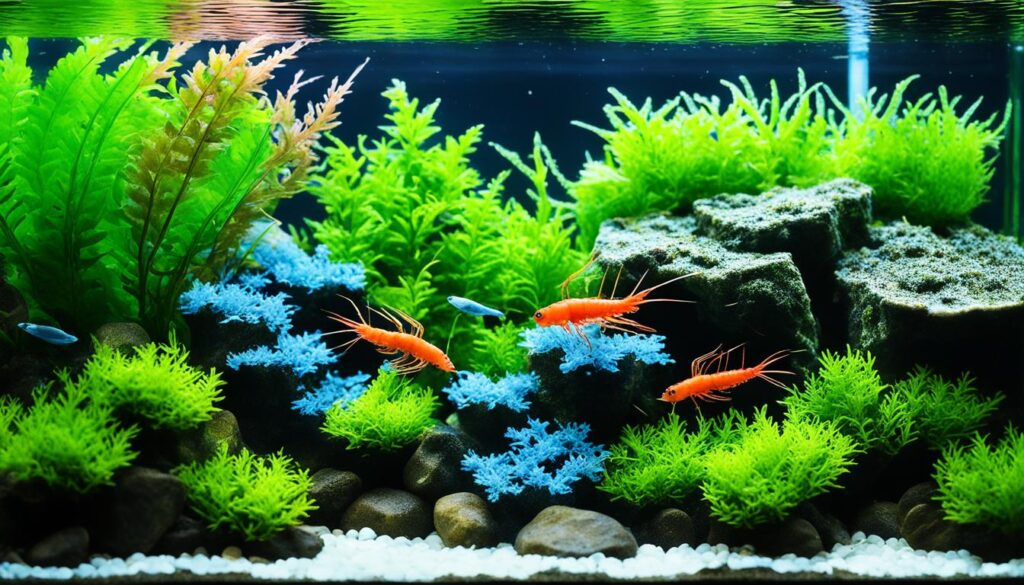
Selective Breeding
Selective breeding is a technique used to achieve desired traits and color variations in freshwater shrimp. By carefully choosing which shrimp to breed based on specific characteristics, you can gradually develop unique and visually stunning variations within your shrimp population.
When practicing selective breeding, it’s important to prioritize the overall health and vitality of the shrimp population. Avoid breeding shrimp with genetic abnormalities or health issues, as this can lead to weakened offspring. Instead, focus on breeding the strongest and healthiest individuals that exhibit the desired traits.
Keep detailed records of the breeding process, noting the parent shrimp, their characteristics, and the resulting offspring. This will help you track the progress of your selective breeding program and make informed decisions for future breeding generations.
Breeding Success and Challenges
While breeding freshwater shrimp can be a rewarding endeavor, it’s important to acknowledge that it may also present challenges. Factors such as water quality, genetics, and the overall condition of the shrimp can influence breeding success.
Additionally, some shrimp species, such as Caridina, have more specific breeding requirements and may be more challenging to breed compared to Neocaridina species. Understanding the specific needs of the shrimp species you are working with and providing the necessary conditions will greatly increase your chances of breeding success.
| Factors Influencing Breeding Success | Challenges |
|---|---|
| Optimal water parameters | Variations in water quality can hinder breeding success. |
| Healthy and genetically diverse shrimp | Inbreeding and genetic issues can impact reproductive capabilities. |
| Age and maturity of shrimp | Young or immature shrimp may not be fertile or capable of breeding. |
By carefully managing these factors and providing the necessary care and conditions, you can increase your chances of successfully breeding freshwater shrimp and enjoying the beauty of their offspring in your aquarium.
Feeding and Care for Freshwater Shrimp
Freshwater shrimp are fascinating creatures that require proper feeding and care to ensure their health and well-being. By providing a balanced diet and maintaining regular care routines, you can promote the longevity and vibrancy of your shrimp.
Feeding Freshwater Shrimp
As omnivores, freshwater shrimp have diverse dietary needs. By offering a varied diet, you can ensure they receive essential nutrients for their growth and development. Here are some key aspects to consider when feeding your shrimp:
- Algae: Shrimp are natural algae grazers and will happily consume the algae that grow in their tank. This provides them with essential dietary fiber and nutrients.
- Biofilm: Shrimp also feed on the biofilm that develops on tank surfaces and decor. Biofilm is made up of beneficial microorganisms and organic matter, which can be highly nutritious for shrimp.
- Commercial Shrimp or Invertebrate Pellets: To supplement their diet, you can offer high-quality commercial shrimp or invertebrate pellets. These pellets are specifically formulated to meet the nutritional needs of shrimp and provide a well-rounded diet.
It is important to note that overfeeding can harm shrimp and negatively impact water quality. Shrimp have small digestive systems, so it’s crucial to provide appropriate portion sizes and avoid excess food waste. Monitor their feeding behavior and adjust accordingly to maintain a healthy feeding routine.
Care for Freshwater Shrimp
In addition to feeding, regular care and maintenance are vital for the overall health and longevity of your shrimp. Here are some essential aspects of shrimp care:
- Monitoring Water Parameters: Shrimp are sensitive to changes in water quality, so it’s crucial to regularly monitor parameters such as temperature, pH, ammonia, nitrite, and nitrate levels. Keeping these within the optimal range will ensure a healthy environment for your shrimp.
- Observing Behavior: Keeping an eye on your shrimp’s behavior can help identify any potential health issues. Look out for any signs of stress, disease, or aggression among shrimp or tankmates.
- Performing Routine Maintenance: Regular water changes and cleaning of the tank are essential for maintaining optimal water quality. Remove any built-up debris, uneaten food, and excess algae to prevent adverse effects on shrimp health.
By following a consistent care routine and paying attention to their feeding requirements, you can provide the best possible care for your freshwater shrimp.
Image:
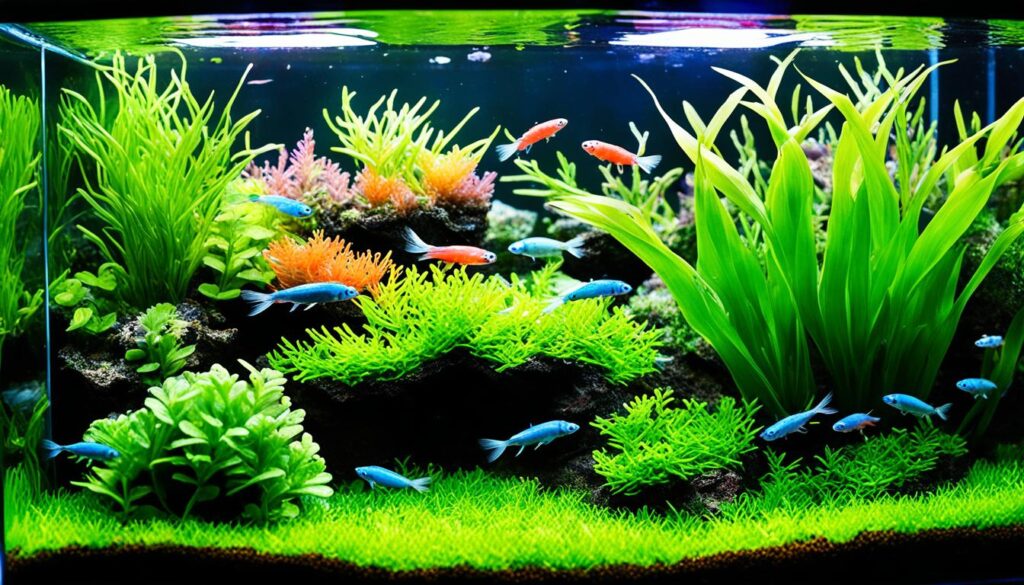
| Feeding Tips | Care Tips |
|---|---|
|
|
Conclusion
Creating and maintaining the ideal water parameters for healthy freshwater shrimp is crucial to their well-being. Understanding the specific water requirements of different shrimp species, such as Neocaridina and Caridina, is essential for providing optimal care. By setting up a suitable tank with the right filtration system, substrate, and hardscape elements, you can create a natural and enriching environment for your shrimp.
In addition to the tank setup, choosing compatible tankmates, such as small peaceful fish and snails, is important to ensure a harmonious community aquarium. Regular monitoring of water quality parameters, such as pH, temperature, and hardness, along with routine maintenance and water changes, will contribute to the overall health and longevity of your shrimp.
Feeding your freshwater shrimp a balanced diet of algae, biofilm, and commercial shrimp or invertebrate pellets is crucial for their nutritional needs. Regular observation of their behavior, as well as maintaining proper feeding habits, will help prevent overfeeding and keep your shrimp thriving.
In conclusion, providing optimal freshwater shrimp care involves understanding their specific water requirements, creating a suitable tank environment, choosing compatible tankmates, maintaining water quality, and ensuring a balanced diet. By following these guidelines and regularly monitoring their well-being, you can enjoy the beauty and fascinating nature of these captivating crustaceans in your home aquarium.
FAQ
What are the ideal water parameters for healthy freshwater shrimp?
Freshwater shrimp, such as Neocaridina and Caridina species, thrive in specific water conditions. Neocaridina shrimp prefer temperatures ranging from 65°F to 84°F, a pH level between 6.5 and 8.0, a general hardness (GH) of 4-8 dGH, and a carbonate hardness (KH) of 3-15 dKH. Caridina shrimp prefer cooler temperatures of 64°F to 76°F, a pH level of 6.0 to 7.5, a GH of 4-6 dGH, and a KH of 0-2 dKH.
What tank setup is best for freshwater shrimp?
To set up a suitable tank for freshwater shrimp, it is recommended to have a tank of at least 5 gallons in size. A sponge filter is often the best choice for filtration. Including a heater and a substrate that allows shrimp to grip is necessary. Adding hardscape elements like driftwood and rocks, as well as live aquatic plants, creates a natural and enriching environment for the shrimp.
Can freshwater shrimp have tankmates?
Yes, freshwater shrimp can have tankmates as long as they are compatible and won’t prey on the shrimp. Small, peaceful fish like Corydoras catfish and small tetras can be good options. Snails, such as Ramshorn or Mystery snails, are also well-suited tankmates for shrimp as they help clean algae. It’s important to consider the size and temperament of other tank inhabitants when choosing tankmates for freshwater shrimp.
How important is water quality and parameters for freshwater shrimp?
Maintaining consistent water quality and parameters is crucial for the health and well-being of freshwater shrimp. Regular water changes, monitoring ammonia, nitrite, and nitrate levels, and ensuring stable pH, temperature, and hardness are essential. By establishing a routine maintenance schedule and testing the water regularly, you can prevent any harmful imbalances that could negatively impact the shrimp.
How do you breed freshwater shrimp?
To breed freshwater shrimp, it is recommended to set up a separate breeding tank with ideal conditions, such as live plants and hiding places. Maintaining stable water parameters and performing regular water changes are essential for successful breeding. Selective breeding can be done to achieve desired color variations, but it’s important to prioritize the overall health and vitality of the shrimp population.
What do freshwater shrimp eat and how should they be cared for?
Freshwater shrimp are omnivores and require a varied diet to thrive. They will eat algae, biofilm, and commercial shrimp or invertebrate pellets. Providing a balanced diet and carefully monitoring feeding to prevent overfeeding is important. Regular care, including monitoring water parameters, observing behavior, and performing routine maintenance, is necessary to ensure the health and longevity of the shrimp.
